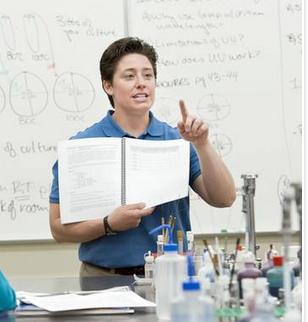A year ago at this time, a STEM Action Center wasn’t even so much as a proposal.
Angela Hemingway was working with the State Department of Education. She was “deep in the weeds” of assessment and accountability issues, and the idea of a STEM center wasn’t really on her mind.

In 2016, the brand-new STEM Action Center could get a big cash infusion from the Legislature. Hemingway, the center’s executive director, is fielding questions from lawmakers about how the money would be used.
In 2016-17, Gov. Butch Otter wants to spend $2.4 million of general fund money on the center — envisioned as a state clearinghouse to promote the “STEM” academic disciplines of science, technology, engineering and math. He wants to put $10 million into a long-term “STEM Education Fund.”
By contrast, the center received $547,000 in general fund dollars for the current budget year, which ends June 30.
Starting from square one
When Hemingway showed up on Aug. 17 for her first day on the job, a desk and chair was waiting in her office a block south of the Statehouse. But there was no sign of a phone or computer.
She has had to equip an office, and start an agency, from square one.
Hemingway hired a program manager, Erica Compton, who started on Nov. 1. The staff of two has been fielding more than 100 applications for STEM education grants — designed for schools, libraries and boys and girls clubs. Awards will be announced Tuesday. The center is also working on professional development. One partnership, with Boise’s Discovery Center of Idaho, will focus on 3D printing.
Hemingway has spent considerable time studying other state STEM centers — starting with Utah, the state that lawmakers used as the template for the Idaho STEM Action Center legislation. She interviewed Utah staff about their professional development efforts and grant programs, and came away convinced that a grant specialist could help Idaho replicate Utah’s popular student STEM grant program.
Part of her job has been to get the business and education communities talking about STEM.
“We don’t have an easy venue to allow them to do that,” Hemingway said. “They really want to interact with each other.”
A collaborative strategy
Interaction between educators and employers is central to the Idaho STEM Action Center’s strategy — and the 2016-17 budget request.
Funding models for STEM centers vary widely. Utah has spent $30 million over three years, relying on state appropriations. Washington’s $10 million annual budget comes from industry donations. Idaho is pursing a blend of public and private funds.
That’s where the $10 million STEM Education Fund comes into play.
The fund is designed to set aside state dollars to match industry donations. The center would have the authority to spend up to $2 million in 2016-17.
Creating a fund, and keeping money in hand, is critical to convince businesses to partner with a state STEM center.

“I think we need to show the private sector that this action center is going to be here for the long haul,” said Sen. Bob Nonini, R-Coeur d’Alene, a co-sponsor of last year’s bill to create the center.
Will lawmakers sign on?
The governor’s budget request caught Hemingway by surprise; she did not propose the $10 million fund. And Otter’s request represents a big departure from 2015, when STEM Action Center supporters and legislative budget-writers scrambled during the waning days of the session to scrape together last-minute and short-term funding. The result was a blend of state dollars and private contributions.
Otter’s 2016-17 proposal has backing from Nonini and House Education Committee Chairman Reed DeMordaunt, who co-sponsored the STEM Action Center bill last session. “We’ve got a huge pent-up demand that needs to be met,” said DeMordaunt, R-Eagle.
But the $10 million fund could be seen as something of a two-edged sword. While it would provide long-term matching dollars, and send a message to potential industry partners, it might also be seen as a way of working around budgetary rules that are designed to prevent legislators from making long-range funding obligations.

So Sen. Shawn Keough is eager to see the details. The co-chair of the budget-writing Joint Finance-Appropriations Committee supports the concept of advancing STEM, but she is a little bit uneasy about placing a brand-new program on autopilot.
“We like to keep track of things,” said Keough, R-Sandpoint.
On Jan. 29, Hemingway will be before JFAC, recapping the launch of the center and answering questions about the 2016-17 budget request.
To Nonini, the funding is an important investment to encourage STEM education, and prepare Idaho graduates for better-paying jobs. But first, supporters will need to sell lawmakers on the funding plan.
“There will be some work to do,” he said.
